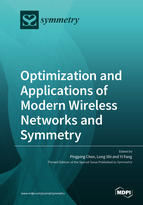Optimization and Applications of Modern Wireless Networks and Symmetry
A special issue of Symmetry (ISSN 2073-8994). This special issue belongs to the section "Computer".
Deadline for manuscript submissions: closed (31 August 2022) | Viewed by 8887
Special Issue Editors
Interests: reliable wireless communications; channel coding for wireless communications; wirelesss physcial network coding; low-complexity channel decoding
Special Issues, Collections and Topics in MDPI journals
Interests: blockchain; mobile edge computing; wireless network coding
Special Issues, Collections and Topics in MDPI journals
Interests: channel coding; coded modulation; wireless communication; machine learning
Special Issues, Collections and Topics in MDPI journals
Special Issue Information
Dear Colleagues,
Channel coding techniques are widely used in modern wireless communications to enhance reliability and spectral efficiency. In particular, low-density parity check (LDPC) codes and polar codes are being optimized for the next wireless standard. Moreover, over the past two decades, physical network coding was invented to improve wireless throughput, together with channel coding. This invokes a great deal of attention on the modern symmetry or asymmetry wireless communications.
Due to the future demands of IoT/5G communications, this Research Topic welcomes research that discusses channel coding, multi-access, physical network coding, and the related communication and network techniques for IoT/5G, and aims to present new research directions in the emerging fields of research.
Prof. Dr. Pingping Chen
Prof. Dr. Long Shi
Prof. Dr. Yi Fang
Guest Editors
Manuscript Submission Information
Manuscripts should be submitted online at www.mdpi.com by registering and logging in to this website. Once you are registered, click here to go to the submission form. Manuscripts can be submitted until the deadline. All submissions that pass pre-check are peer-reviewed. Accepted papers will be published continuously in the journal (as soon as accepted) and will be listed together on the special issue website. Research articles, review articles as well as short communications are invited. For planned papers, a title and short abstract (about 100 words) can be sent to the Editorial Office for announcement on this website.
Submitted manuscripts should not have been published previously, nor be under consideration for publication elsewhere (except conference proceedings papers). All manuscripts are thoroughly refereed through a single-blind peer-review process. A guide for authors and other relevant information for submission of manuscripts is available on the Instructions for Authors page. Symmetry is an international peer-reviewed open access monthly journal published by MDPI.
Please visit the Instructions for Authors page before submitting a manuscript. The Article Processing Charge (APC) for publication in this open access journal is 2400 CHF (Swiss Francs). Submitted papers should be well formatted and use good English. Authors may use MDPI's English editing service prior to publication or during author revisions.








